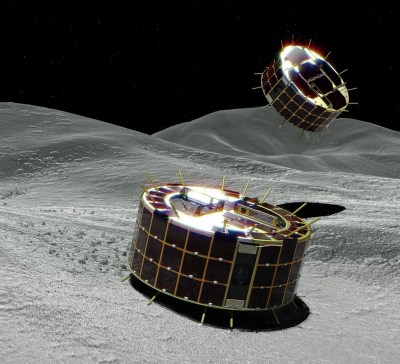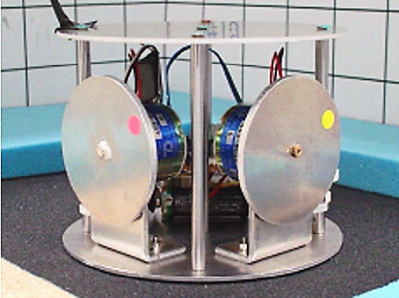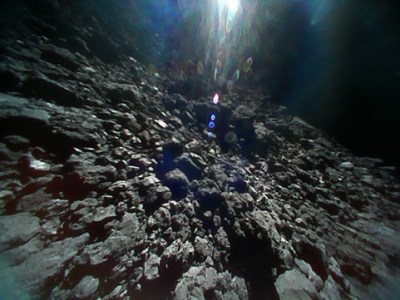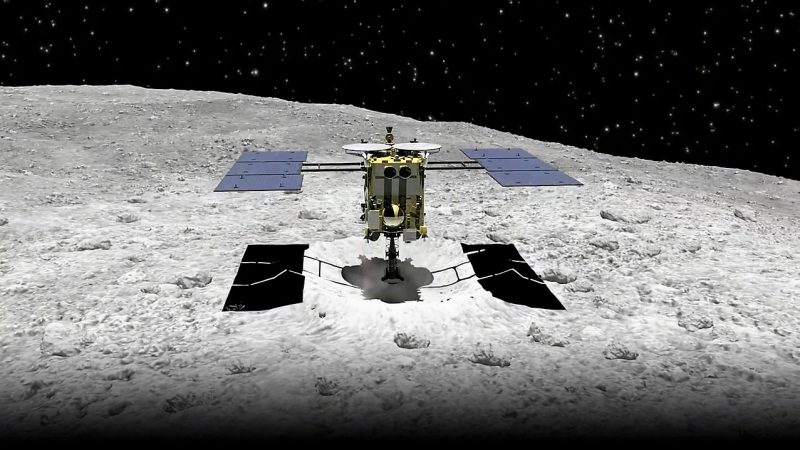Exploiting the resources of the rock-strewn expanse of space between Mars and the outer planets has been the stuff of science fiction for ages. There’s gold in them ‘thar space rocks, or diamonds, or platinum, or something that makes them attractive targets for capitalists and scientists alike. But before actually extracting the riches of the asteroid belt, stuck here as we are at the bottom of a very deep gravity well that’s very expensive to climb out of, we have to answer a few questions. Like, how does one rendezvous with an asteroid? What’s involved with maneuvering near a comparatively tiny celestial body? And most importantly, how exactly does one land on an asteroid and do any useful work?
Back in June, a spacecraft launched by the Japanese Aerospace Exploration Agency (JAXA) finally caught up to an asteroid named Ryugu after having chased it for the better part of four years. The Hayabusa2 was equipped to answer all those questions and more, and as it settled in close to the asteroid with a small fleet of robotic rovers on board, it was about to make history. Here’s how they managed to not only land on an asteroid, but how the rovers move around on the surface, and how they’ll return samples of the asteroid to Earth for study.
These Are Not the Rovers You’re Looking For

As interplanetary spacecraft go, Hayabusa2 looks pretty much like what you’d expect, with two long rectangular solar panels flanking the cube-shaped main part of the craft. It is similar in design to its predecessor Hayabusa — the name means “Peregrine falcon” in Japanese — which explored the asteroid Itokawa in the mid-2000s and returned samples of the asteroid to Earth. Hayabusa was equipped with a robotic rover, dubbed MINERVA; sadly, a communication error caused the rover to be released while Hayabusa was ascending from the asteroid and the rover was not captured by its minuscule gravitation. Hayabusa2 was to give the landing attempt another go, and this time the mothership carried not one rover but four! Three of them were improved MINERVA-II rovers, with a German-built vehicle called MASCOT as the fourth.
These are not the type of “rover” you are picturing. We’re all familiar with the Apollo-era lunar rovers, or even the Mars Curiosity rovers, which are wheeled vehicles that can be driven around by remote control. But driving around on a tiny fleck of space rock with 1/10,000th the acceleration due to gravity that Earth has is a problem. With so little force pulling a rover down, the wheels would lack enough friction to get any traction, So rather than wheels, the rovers all hop around the surface of Ryugu instead.
Lose the Wheels; Go with Torquers

There are plenty of ways to make a rover hop, including small jets of compressed gas, arms that deploy to push off against the asteroid’s surface, or even springs that propel the rover upwards. But the MINERVA-II rovers went with a different solution: small, motor-driven flywheels called “torquers.” Torquers work by modulating their angular velocity very carefully, producing a moment of torque that can flip the rover up into a ballistic orbit above the surface of the asteroid. With two torquers at a 90° angle to each other, the rover can control not only its speed but its altitude as well. This lets the rovers set down anywhere else on the asteroid.

The first two MINERVA-II rovers were released from Hayabusa2 on September 21st, and both successfully landed on the surface of Ryugu. Both rovers have successfully hopped around the asteroid since then. The rovers, tiny flattened cylinders 18 cm across and about 1.1-kg each, are both solar powered and are designed for long-term operation on the surface. Their instrument packages, which include cameras, send data back to the mothership whenever it’s in view.
The MASCOT rover, on the other hand, is a battery-powered, 10-kg package that’s designed to conduct spectroscopic and magnetic studies on Ryugu’s surface. Designed for a limited mission and with enough power for only one hop, MASCOT was sent down to the surface on October 3rd, and managed to send back data for 17 hours before shutting down. The one remaining MINERVA-II rover, a larger model with more sensors and three other types of mobility systems in addition to the torquers, is not scheduled for deployment until July of 2019.
Shots in the Dark
While the rovers are getting a lot of attention with all their hopping about, the mothership has a few tricks of her own to perform. If all goes to plan, sometime in January of 2019 Hayabusa2 will maneuver slowly and carefully down to the surface of Ryugu and extend a sampling probe to the asteroid’s surface. The probe is designed to collect anywhere from a few milligrams up to 10 grams of sample. To accomplish this, the sampler will fire a 5-g slug of tantalum down the barrel of the sampler and into Ryugu’s surface. Ejecta will collect in the sampler and be sealed inside a reentry vehicle for return to Earth.
Hayabusa2 will perform a similar collection later in the year, and shortly thereafter put on a really big show. After maneuvering to about 200 meters above the surface, it’ll use a 4.7-kg shaped-charge to blast a 2-kg copper disk down at the surface. The projectile will impact at about 2 km/s and blast a new crater into the asteroid to expose material that has been sequestered from the ravages of space. Hayabusa2 will scamper off to the other side of the asteroid to avoid the debris cloud, but not before deploying a remote-controlled camera to monitor the scene of the crime. Once the dust settles, Hayabusa2 will make one last sample pickup from the crater before getting ready for the long trip home in late 2019.
All things considered, the mission to Ryugu is incredibly ambitious, and should yield a wealth of data on asteroids. The mission has many moving parts, both literally and figuratively, and there’s a significant chance that something will fail before the mission wraps up. But the fact that everything has gone so well thus far is encouraging.
If all goes well, the first few grams of what is currently estimated to be $83 billion worth of iron, cobalt, nickel and other substances locked up in the asteroid will float back to Earth over Australia sometime in 2020. And if that marks the point at which asteroid mining becomes something more than science fiction, it’ll be because of the Hayabusa missions and what their hopping rovers teach us.
















What is this “torquer” you speak of and why does it look like a reaction wheel?
https://en.wikipedia.org/wiki/Reaction_wheel
It’s a reaction wheel optimized for slow spin-up and quick braking to produce a large torque for a short time.
The test setup looks like reaction wheels, the end design looks more like a hammer being swung around. On top of that a reaction wheel is intended to orient a free flying spacecraft. The torquers on the MINERVA-II and MASCOT rover are intended to apply a torque through the vehicle to the surface to propel the rover in whatever direction desired. Subtle difference, but probably why they call them torquers and not reaction wheels
“And if that marks the point at which asteroid mining becomes something more than science fiction, it’ll be because of the Hayabusa missions and what their hopping rovers teach us.”
Self-building machines. Creating a factory in space. Like in the Bobiverse.
Was talking to a venture capital manager recently. The amount of venture money going into asteroid mining is staggering. And quiet.
Gee, I sure hope those asteroids aren’t just made of useless* rock.
* or extremely expensive roadbed material
“Roadbed material delivered to your LAT/LONG +/-200km or your money back!”
Orbital Paving LLC
Far from useless no matter what the asteroids are made of:
Replace: “Roadbed material delivered to your LAT/LONG +/-200km or your money back!”
With “Roadbed material delivered to your LAT/LONG at 12,000 m/s if you don’t pay!”
Its a much better business model.
That is also why the US already needs that additional branch of defence. (Space Force)
Classic science fiction ideas coming at us faster than we think. I can see writer of “The Moon is a Harsh Mistress” – Robert A. Heinlein smiling down on us. :-)
Thanks for the TL;DR and for putting at the top.
Putting a artificially g spaceship inside the crater of a near earth asteroid. Then cover up most of the spaceship inside would be an amazing task. Anchor down area with material and strategically anchor cover the rest of the asteroid with solar panels. And do missions within the inner solar system would be nice.
I’m not sure I quite follow o.O
Attach a habitat to an asteroid and ride the thing around the solar system. As long as the asteroid is periodic and comes close to earth every so often, you could put people on there and resupply them with rendezvous missions every couple of years. The habitat would need to be large enough to simulate some gravity because these asteroids usually don’t come around enough for people to live on them in micro-gravity without significant health problems. A year on the ISS can leave you with some serious bone loss and muscle atrophy even with exercise. However, a facility of that size and especially the torque supplied by a spinning artificial gravity space station would cause quite a bit of change to the trajectory of the asteroid. As cool as an asteroid-based space station sounds, it would be very difficult and maybe impossible. You are probably better off building an entire ship to perform the same orbit.
It’s all good science until someone discovers platinum (or some other valuable substance) in large quantities and fails to keep it a secret. Then its “Spaceward Ho!!” for every venture capitalsist out there. Welcome to New San Francisco.
And then you land that payload on earth and discover that you just turned platinum from something rare to something not rare. In the 1850s an aluminum tea set was the peak of extravagance – more expensive by weight than gold, and a very rare and unusual metal to see refined. By 1930 it was cheap.
I really don’t expect a price drop in platinum to be as big as what happened with aluminum. Electrolysis opened up the door too relatively cheap aluminum. No such process is known to be possible with platinum without a “philosopher’s stone” or nuclear conversion. :-) Platinum is amazingly useful and even an increase in availability of a couple orders magnitude wouldn’t shrink it’s price too much. Our appetite for it is insatiable for all practical purposes.
Space platinum would still be expensive, space flight ain’t cheap, don’t see that changing anytime soon, even with all the private space companies competing. Mining the ore would be one thing, but need to separate the metal. Limited space and wait, would want to be hauling back, mostly useless rock. Wonder if they already know which asteroids will be resourceful, and which are dead rock. Whole lot of them to just pick one at random, and hope for some return. Think they’d be better off building sort of a mining ship, that lands, does it thing, until a refueling ship can fill them up for the return trip.
Wonder how long this mining thing has been in the works. The focus has been space stations, with no interest in messing around on the moon, which has some gravity, people could stay the quite a bit longer. Even though they are aware of the health issues, they still keep going longer. Maybe looking for a cure, or way to mitigate weightlessness.
Actually the valuable material would quickly end up being refined right at the site where the ore is and eventually some of it will be used to produce more mining and refining equipment. Getting stuff into space is mostly a “seeding” process. Yea, it’s expensive up front but can get much better down the road. They may find plantium in space but they will find even more iron and other useful materials and will put them to work right there to satisfy their own local needs. The excess high value to mass ratio stuff can be shipped to Earth in exchange for things that mining facilities haven’t yet figured out how to make for themselves efficiently. It’s better to think like an 18th century Englishman than a 16th century Spaniard. You make more money building up your colonies and rebellion is less likely. (You need to keep friendly relationships going between Earth and space-centered colonies/communities/nations. It takes expensive rockets and other high tech for Earthlings to reach out and touch them while all they have to do is throw rocks. :-)